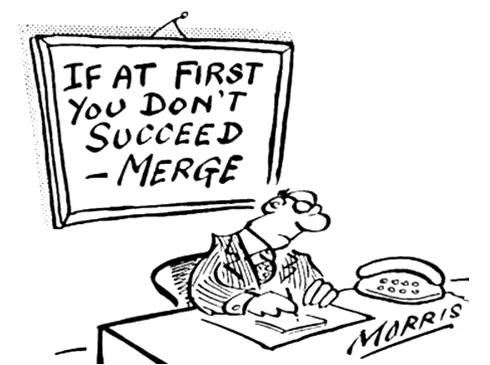Get free review of your pitch deck by Kapso

6 chapters
In simple terms, a merger happens when two existing companies voluntarily come together to form a single entity. Usually the companies that decide to merge are of equal size.
In simple terms, a merger happens when two existing companies voluntarily come together to form a single entity. Usually the companies that decide to merge are of equal size. One of the main reasons why companies opt for a merger is to gain/increase market share and expand into new areas.
Some of the other reasons why companies merge with other companies include:
The relative success or failure of a merger depends on the criteria used to evaluate success and the timescale chosen to make the evaluation. It appears to be true that relatively few mergers create long-term shareholder value in their own right.
Some of the issues related to mergers are:
While a merger allows companies to reduce competition, it can also give rise to monopoly in the market. The market goes into monopoly when there exist only a single manufacturer/supplier for a particular product and/or service. With reduced competition and high market share, the company can demand higher price from the customers. Even in the absence of monopoly, reduced competition more often than we think, leads to higher prices for the customers.
When two companies merge, it often results in the reduction of labour force of the two companies. While this is one of the methods adopted by the company in order to save cost, it will have a negative impact on the employees. When they live in the constant fear of losing their job, it reduces employee motivation and results in reduced productivity.
The merging of two companies is more of a merger of the people associated with the companies than just the combination of two brands. Hence it is extremely important to ensure the compatibility of the culture prevailing in both organisations. If the two merging companies have different cultures and norms, then it can give rise to conflicts.
In the merger of two firms, it is important to consider the consumer attitude towards the individual companies and whether or not they perceive the two companies to be compatible. If the consumers don’t have the same perception about the individual companies, it will result in the merged company losing customer support.
When two companies decide to merge together, it is mainly to achieve economies of scale. A company is said to achieve economies of scale when it is able to reduce the average per-unit production cost with increased production. But at times, when two companies merge, being the bigger one will actually create dis-economies of scale since per-unit production cost increase due to increased coordination costs.
In an acquisition, a company buys more than 50% of or all of another company’s ownership to gain control over it. As part of the deal, the acquiring company buys the other company’s stock and assets.
The following are some of the reasons why a company opts to acquire another:
When a company chooses the path of acquisition, the idea is to increase their revenues by acquiring a functioning company that will contribute to the income. However, acquisitions can present some difficulties and actually put the acquirer and the acquiree at a disadvantage.
Some issues that should be considered before pursuing an acquisition are:
Mergers and acquisitions both involve the combination of existing companies into a new larger entity. In the case of a merger, both organizations negotiate around the terms and conditions of the merger and seek shareholder support. Mergers therefore tend to be more amicable. In an acquisition one company buys another company. In some cases, there may be no negotiation or prior approval. A company might therefore consider a merger where it needs to acquire new or complementary skills or resources but does not necessarily want to buy another company. One obvious reason for this might be the cost of the target company. The nature of the merger could take several forms. In most cases of a merger of equals, both companies must be prepared to make significant organizational changes and variations in working practices. If a company is not prepared to do this, a simple acquisition might be a more favourable option.
1. For businesses, merger is an attractive option because it enables them to reduce the cost of operation, accelerate the growth, penetrate the market with more ease and last, but not the least, create synergies.
2. Acquisition is a good option for a company that aims to achieve high growth in minimum time.
3. While mergers and acquisitions provide business with immense opportunities, they also create certain issues in terms of people management, clashing work cultures and increased debt.
4. A merger happens when a company is looking to obtain skills and resources but not necessarily by buying another company whereas an acquisition is where one company buys another company.
Kapso is an ISO-certified boutique M&A firm founded out of a passion to provide best-in-class services to our clients. We distinguish ourselves by the depth of our knowledge of India's SME landscape, and we specialize in assisting firms with the acquisition and fundraising process from the initial stages of collateral preparation through deal closure.
We aspire to become a long-term valued partner of businesses and entrepreneurs, assisting them in realizing their full potential by providing a unique viewpoint, blend of expertise, and perseverance to our clients' needs.
2nd Floor, Pantomath Nucleus House, Saki Vihar Rd, Raje Shivaji Nagar, Marol, Andheri East, Mumbai, Maharashtra 400072